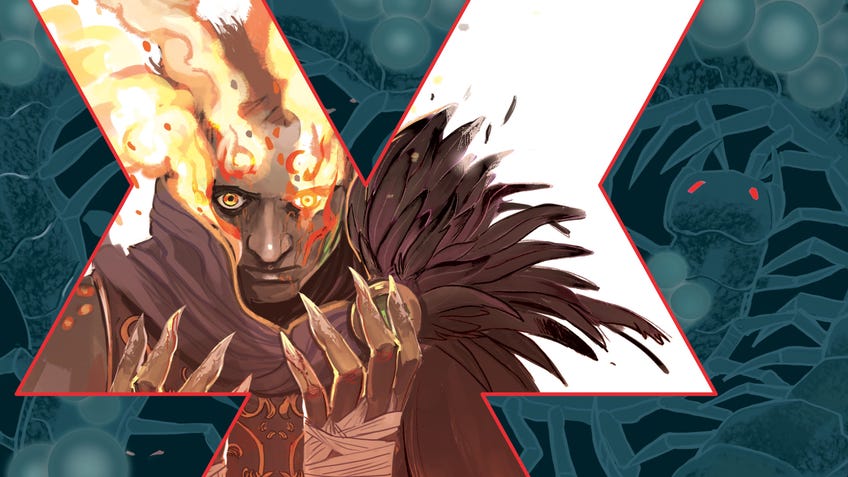“Why do we play games?”: DIE’s creators and Grant Howitt discuss adapting the comic into a tabletop RPG
The tabletop team-up have planned more than a simple almanac for Gillen and Hans' twisted polyhedral world.
Having just finished an award-winning run, tabletop RPG-themed comic DIE is already heading into a new medium thanks to a sourcebook adaptation courtesy of Rowan, Rook and Deckard. Creators Kieron Gillen and Stephanie Hans have spent nearly three years telling the story of a group of friends returning to a hobby hellscape where they are transformed into Personas and wield the power of the dice against their own troubled pasts and interpersonal trauma.
The collaboration will launch its Kickstarter campaign in November of this year and plans to produce a single, comprehensive book, a la Heart: The City Beneath. It will feature new art from Hans and other notable illustrators, along with writing from some of the indie RPG scene’s strongest voices. A quickstart version will be available, too, offering an early look at the game’s unique fantasy-classes-with-a-twist Personas and how the book essentializes DIE’s strengths.
Ahead of this, Grant Howitt, Kieron Gillen and Stephanie Hans sat down to chat about the process of inviting roleplay groups into DIE’s universe, what those groups should be prepared to see and how this pairing makes so much sense on paper.
Grant, how did they rope you into this, or how did you chase them down and beg for this project?
Grant Howitt: It was maybe about the start of this year, I think, when Kieron got in touch with us. I like to think I'm now friends with celebrity author Kieron Gillen, whereas before I had oscillated nearby celebrity author Kieron Gillen in various London pubs. The DIE team - Kieron, Stephanie [Hans] and Kieron's editor, layout and partner, Chrissy - were looking at people to publish the book because the comic was obviously a huge success. Kieran had written a role playing game to go with it but was after some assistance in making that into a real thing.
The challenge is to present [sately] tools in a way in which people aren't going to look at them and go, “Ah, sounds like some lefty bullshit to me.”
It really feels like a natural pairing: the ethos of DIE, the look of DIE, the style of DIE - very tongue-in-cheek. When I saw the slight pulpiness and the emotional aspects of it, I recognised the stuff we try to bring to most things we make, as well. This is our first time really dealing with an external IP, something we’ve actually tried to veer away from because I really don’t like working with someone else’s toys. But it seemed like a natural fit, and Kieron had already written the book. So, really, that’s a great deal for us.
Kieron Gillen: I remember at this party, Grant mentioned Heart being their next game. The whole dungeon as an externalisation of characters’ internal trauma, and woes and dreams - that’s pure DIE. Rowan, Rook and Deckard is a small British company with values we share, they are a living wage employer and we didn't have to build a relationship from scratch. Maybe we could work together, hang out and make a little book.
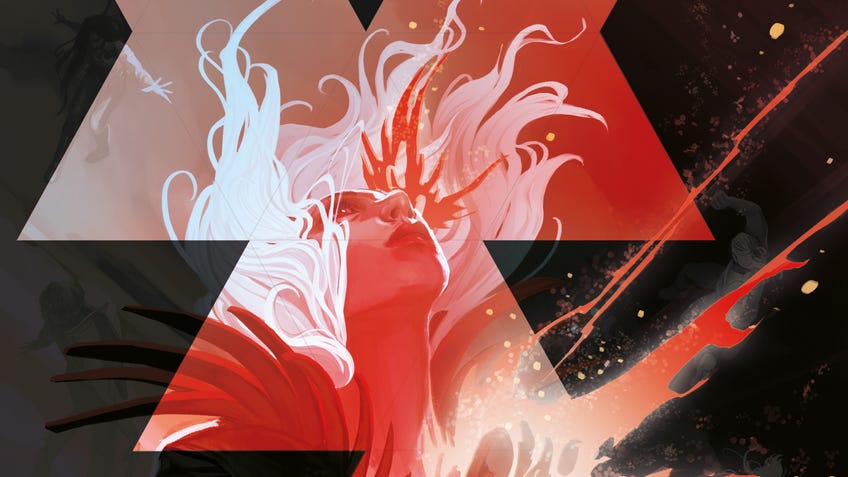
Stephanie, is your job going to change very much at all, working on an RPG book versus a comic?
Stephanie Hans: Kieron is very good at letting me do my own thinking about things, which is one of the reasons why I really love working with them. People always ask me how I think about the characters from the comic, but I just think about them as real people. This is the way I’m going to approach the illustrations in the book. I had some RPGs when I was younger, obviously, but I think there is some bridge to make with both more modern illustration and very old school illustration. I'm more interested in developing that part of the art, you know? Finding something between old school illustration and more modern - a bit less noisy images, I think, could be rad.
How has illustrating for an RPG book instead of comics altered your perspective or given you new ideas?
SH: There are inspirations from the comics that I want to use for the RPG. My main inspiration for the flashbacks in the comics comme from a Russian artist in the 1920s called [Ivan] Bilibin. This is the direction I’ve been wanting to go for a long time - something new, beautiful line art. My art is always very busy, and I know that makes its style, in a way, but I always mourn a bit the fact that I’m not Moebius… everybody wants to be Moebius, but I at least want to add cleaner art to the book.
Will the art direction from the RPG book be substantially different from the art in DIE, the comic?
SH: They will be a bit more full of detail and thoughts. My traditional painting style is not that far from digital art. I have a few covers that are traditionals in the market, and people usually don’t notice the difference. So, I don’t think it will be that different, but in the composition, of course, there will be some mock-up involved.

KG: A lot about Stephanie as an artist is actually pushing herself in different places. We want to highlight different areas because she does nice things like pencil sketches in the trades, which are real-world stuff. As well as the incredibly lush stuff, her light stuff is a bit more smaller and human. She’s got a big, wide toolset, and we want to use it all.
Grant, you mentioned not normally playing with other people’s toys. What makes DIE RPG the exception?
Part of DIE is asking, “Why do we play games? Why would these people be attracted to games?” This is in the comic a lot, and we’re bringing that to the RPG.
GH: I trust Kieron, and I trust Stephanie. She is so good at drawing and making pictures that it is a different sphere to what I could possibly ever hope to understand. So whatever she creates, we will work with, which is kind of how we work with a lot of the artists we approach. As far as Kieron goes, I'd read the mechanics. I knew it was good. I knew that the world of DIE is so tremendously vague it's very hard to get wrong, which just slots into a lot of our stuff like Spire and Heart. Also, it's not massively established. There aren’t things in which we can get wrong, there isn't a fan base who can go, “Actually, in issue 12…” That’s not going to happen.
Kieron has written the book - he has written far too much for the book - and we've had some lovely chats about how to implement setting and how to implement the very sort of audience-facing, player-facing setting of DIE. Which is, “Here are some ideas. Go, and make up your own thing.” I am more than happy to work with that to make sure it is the best game, the best product, the best book available.
Can you talk about the work needed to transform DIE RPG from the rules that exist online to whatever comes out the other end of the Kickstarter campaign?
KG: There’s this really great key I discovered on the keyboard called delete.
GH: That’s the thing. We’re saying it’s very long, but we’ve already cut back a lot of it. The biggest job for me, as an editor and a producer, is to look through the beta and say to Kieron, “This is really good, and you have to trust yourself.” There’s an awful lot of stuff in the beta where Kieron is basically explaining his point before he makes it. It was an informal document before, so shifting to a formal document whilst keeping Kieron's voice and the playfulness, the fun aspect of it is the biggest job that we have. Take it from a “Hey, buddy, you want to play a roleplaying game?” and it's sort of like pulling up his coat and pulling out a PDF to “This is a £40 book that is beautiful and engaging and exciting to pick up and read.”
How will groups who play DIE Core and want to continue with those characters transition into the longer campaign stuff?
KG: You will have to tweak a few things. You have to massage it a little bit, but it's completely doable. There’s a whole section of DIE Campaign at the back of the book in terms of running your own classical sort of campaign, and you can handle it yourself. There’s also a very specific structure, which basically involves making a representational d20 because [the world of] DIE is a d20. Basically, it will be revealed that your first DIE Core game was just one of the regions, which you realize as the rest of the map unfolds around you.
Given the physical book, what is the fate of the free beta version available now?
KG: The current beta is a complete mess. You’ve got to piece it together from multiple documents. To be honest, the basic version still works, but we’re still working out what to release. I don’t want to say anything I can’t promise.
GH: There is a desire in any sort of IP-focused RPG adaptation for the game to be an encyclopedia of the world. So, one thing which we are trying to do with this is rather than saying, “Right, here’s the main exports of this particular country in DIE, and here are the movers and shakers behind the scenes,” we want to evoke what DIE is. It would be inauthentic to just publish the wiki of the world which Kieron has made. For the game to function, it has to come from the GM and the players. We are not interested in creating a reference text for the comic book. We want to enable and empower people to look at what their fantasy influences are, trust their obsessions and then work those into something really powerful and evocative. We are giving them the tools to do that.
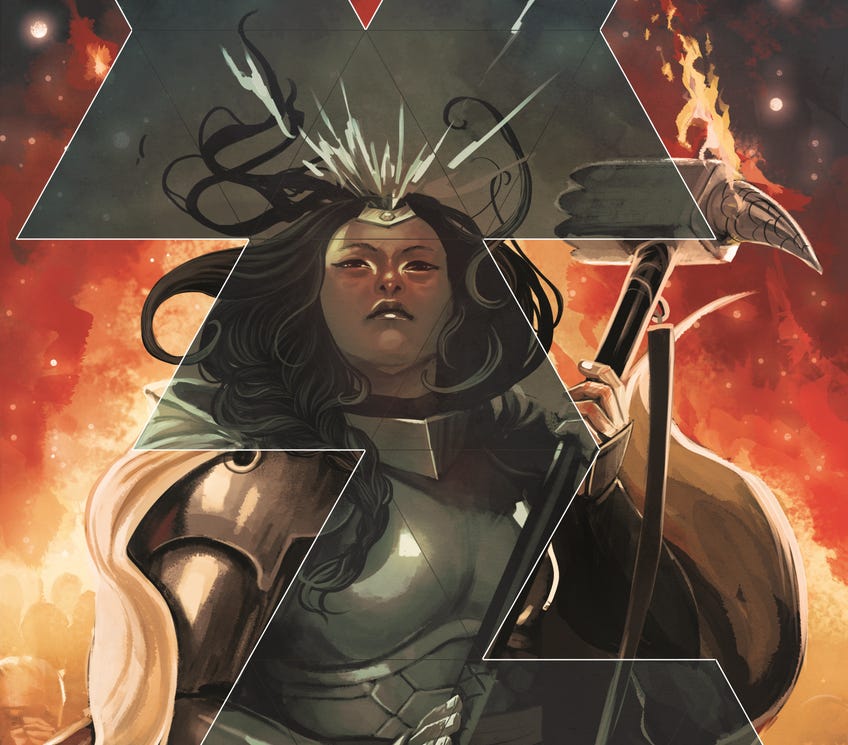
What existing games or systems did you look at to build a scaffolding for your own ideas?
KG: It’s an act of hubris to design a game from scratch, you know? I should have just nabbed the [Powered by the Apocalypse] system and run it like that. On a meta level, it’s meant to be something sold in the early ‘90s. So, it had to be a dice pool system. I wanted it to be really simple. I wanted to get the fuck out of the way. I really couldn’t do something like PBTA because the game is about reality versus fantasy. Are these [players and NPCs] real? Are the people you meet real? If the game system explicitly says these people are different from you… Oh, no. You’ve answered the question. So, for narrative reasons I’ve come back to doing it quite like a trad system in some ways.
There’s honestly so much indie influence in this game - Forged in the Dark, Belonging Outside Belonging. If you think about it, there’s a middle bit where that’s about 10 minutes of a Nordic LARP. In some ways, the game is about the conversation with traditions. You start with this very storygame idea then after character generations it's kind of a classic Arneson/Gygax model game, where you have a GM and players as a strict dichotomy.
How is the book being designed to approach players who might be coming in from outside either the tabletop community or the comics community?
GH: One of the biggest stumbling blocks I’ve found with roleplaying games is people struggling to get into it and struggling to take the world seriously. What do I know about the world, and What don't I know? Is it weird there’s an orc here? [In DIE RPG] you can make up the fake person, and then go, “What, orcs?!” and then completely disbelieve everything that's going on. You can metagame and start calling stuff out, and the world can react in-character.
We want to enable and empower people to look at what their fantasy influences are, trust their obsessions and then work those into something really powerful and evocative.
KG: That’s the best thing about DIE. It just changes completely what the people are, the persona of the game, which is a joy. Play someone who knows nothing about RPGs and it's just perpetually confused. “What is this green thing? What's an orc?” That’s quite fun to play if you’re an RPG expert.
SH: I'm actually a very good example of a newcomer because I used to play roleplaying games when I was 20, and I always hated introductions. With the way [DIE RPG] is constructed, you skip the awkward moment where you enter a tavern and build a group of adventurers like, “Hey, I’m the only other real person here. Obviously, I’m going to talk to you.” I really like that aspect as a very shy person.
One of the large conceits of both the comic and the RPG is asking players to bring in a lot of their emotional baggage and trauma, which shapes the world. How do you feel about that ask, and how have you designed some balances and safety tools to help groups deal with it?
KG: The safety-proofing of the game was always really important to me. We link to tools, we talk about tools, and there's a lot of the game that’s about creating a community at the table. At the same time, I almost don't want to oversell the trauma. These are real people, but it’s possible to play DIE really lightly where it ends up becoming a bit more like Jumanji. My personal way of running DIE just goes between the sublime and the ridiculous, constantly. It's just making sure people feel cared for.
Part of DIE is asking, “Why do we play games?” This is in the comic a lot, and we’re bringing that to the RPG. Why would these people, these characters be attracted to games? And, of course, the main question is why are you attracted to games? What are we getting from this?
It really feels like a natural pairing: the ethos of DIE, the look of DIE, the style of DIE - very tongue-in-cheek.
GH: When we wrote Spire, the first bit in the GM guide is, “Hey, try not to fuck each other up.” If there are people who are fundamentally cool, and they’re already going to get on, they’ve probably already heard about safety tools, and they probably don’t need them. Not because they're not required, but because they have the means to negotiate without explicit tools. The challenge is to present these tools in a way in which people aren't going to look at them and go, “Ah, sounds like some lefty bullshit to me.”
I think the way in which I approached them is that they're safe words. You can have an awful lot of fun, and you can play around and push boundaries, you can mess stuff up, but there is always the capacity to go, “No thanks. I’m not interested in that,” and not be judged nor have to explain yourself. It’s why I always use the X-Card in any game I run, and I try to get people to use this when it’s something they’re just not into as opposed to a big problem.
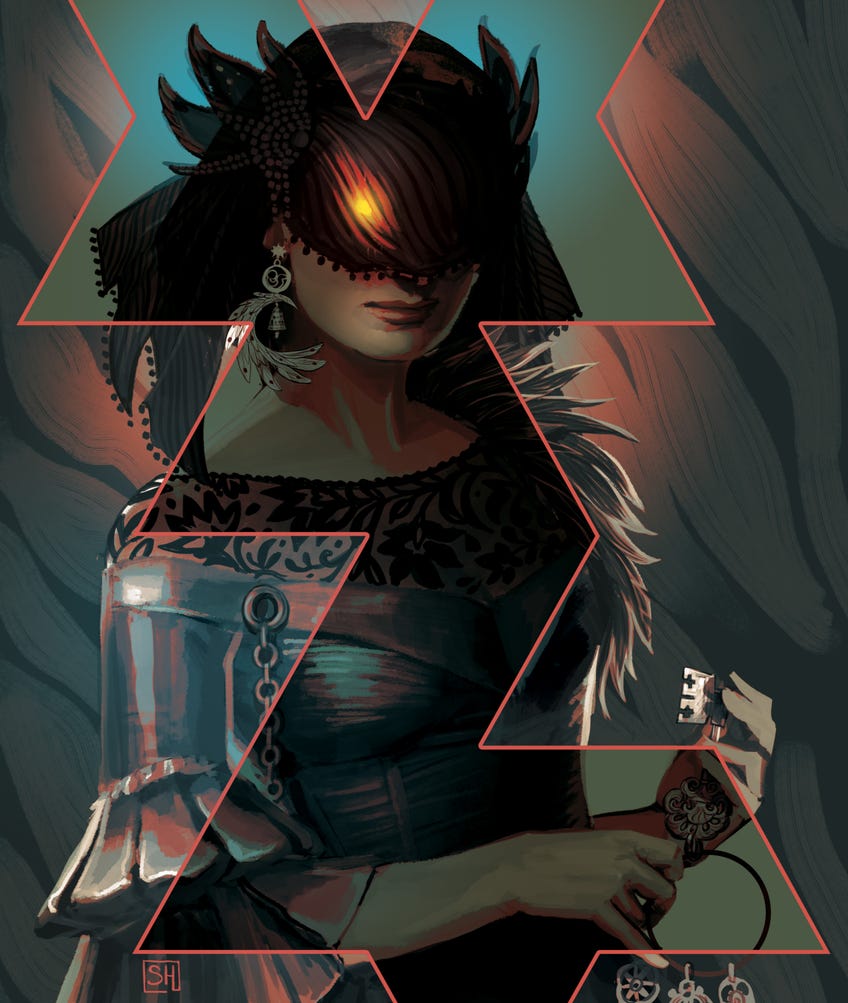
What are the current plans for the Kickstarter campaign launching in November?
GH: The brains behind the operation in Maz Hamilton, and the plan is we’re going to go for a book. Definitely one kind of book. Hopefully, we’re going to have three kinds of books of increasing beauty. We want to give people the opportunity - once we have enough money coming in to actually float this sort of thing - to make something gorgeous where the people who want to support us can go, “Here’s £300 I apparently have to spend. Go!” Quite what that is, we’re not sure, yet. I don’t know whether you’re aware, but there’s no paper in the world and no one’s shipping anything anywhere.
I was going to ask if the global shipping and material shortages had changed your plans.
GH: Thankfully we won’t be printing until next year, and we won’t be fulfilling until next year. Rather than just closing our eyes and hoping, we have ways and means. We are trying to remain as dynamic and flexible as possible. What Rowan, Rook and Deckard are famous for in this sort of thing is transparency. And I’m really hoping we can bring that to [the campaign] and say, “It is going to be beautiful, it is going to be lovely. We maybe can't say precisely what it's going to be.” This is about as close as I get to marketing speak.
How have the comics influenced the layout of the book?
KG: We want to do comics inside the manual, both for introduction fiction but also as examples. I’m of a certain age and remember one of the first RPGs I ever read was Dragon Warriors, and they did the rules stuff in comic book form, which worked really well. New comics, by the way.
The DIE comic has some very specific references in it. How do you create the creative space for unique influences based on each individual group?
KG: One of the best things that came out of our conversation is how we’re going to do a bestiary. We’ve got the classic DIE monsters - we’ve got the Fallen, the Fair, we’ve got DIE itself. But then we’ve got all your classic D&D monsters. Along with these really basic ideas of how to use them, you’ve got a list of statements that make it easy to make them your own.
GH: We’re hoping it’ll be a valuable resource aside from DIE. I was really keen for Kieron to write not a Fantasy Monsters 101, but a 103 course. Here is where goblins are culturally important. Here is an interesting fact about goblins. Here is something which goblins love. Players can then take that and apply it to, say, a master in this realm who is really obsessed with Hideo Kojima.
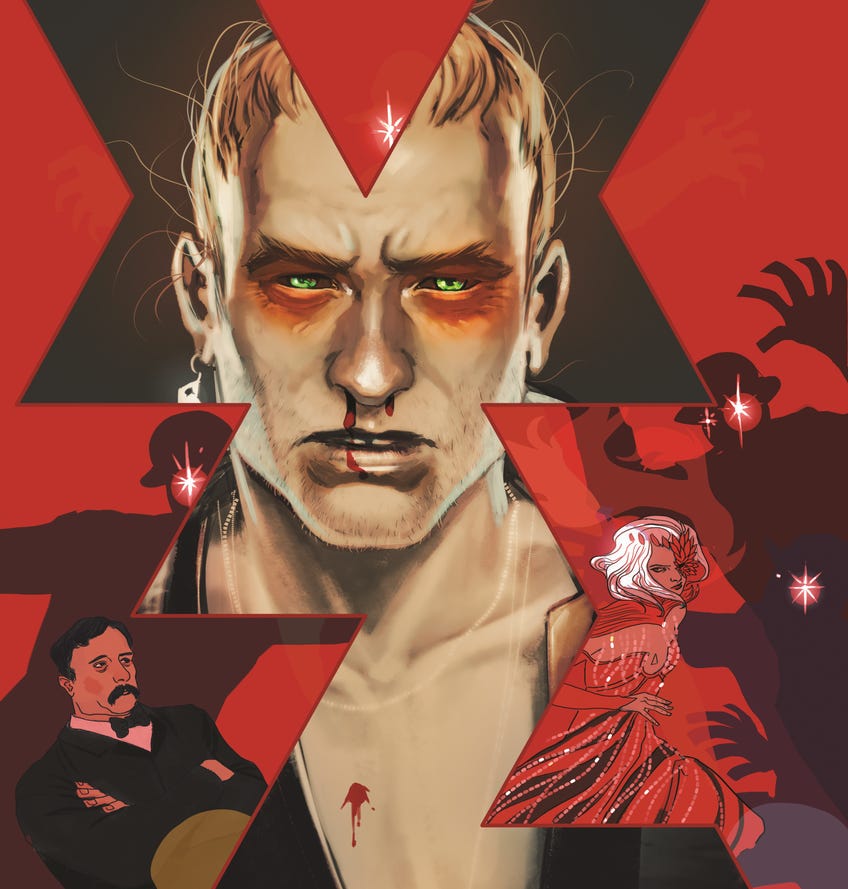
Is this the beginning of Kieron the RPG designer instead of, or alongside, the comics writer?
After The Wicked + The Divine, I had two contradictory thoughts. One of them was to try to be a more mainstream writer - let’s pursue Hollywood and mess around and see what that feels like. The other was to go full-on weird and do whatever I wanted to do. DIE RPG was a big part of that, and I’ve enjoyed it enormously. I'm lucky to have been successful enough to try weird things, and that’s an incredible privilege. My background is strictly working class, and there’s never been a safety net for what I’ve done, ever. As Grant says, writing about elves and keeping a roof over my head has been my goal.
This is an extension of what I’ve always done privately, but now I’m sharing the stuff with people a bit more. This is very much a pure artistic statement for me, unless it makes too much money. Then, suddenly, it’s work again.
This interview has been edited for clarity and length.
